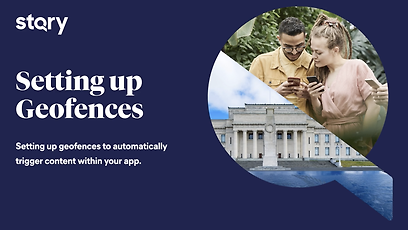Did you know that you can integrate location-specific content into your STQRY app? With geofencing and bluetooth beacons or GPS, you can create a unique, tailored content experience for your visitors that is determined by their location within your site.
There are various types of geofencing models that will make your app more interactive and enhance the user experience. We’ll go through the differences and what may work best for your app below, but let’s go over the concept of geofencing first.
What is Geofencing?
A geofence is a virtually established perimeter for an in-person geographic location. By building a geofence within your app, you can automatically trigger certain content to pop up as users enter the digital boundaries in real life. In other words, if a user walks into the spot set by the app builder, the user’s phone will alert them with the content associated with that spot.
You can set up as many geofences as you’d like on a given site, and you can even trigger different types of content within your geofence such as audio, video, and text – all with the intention of giving the visitor more information about your site and increasing your app’s interactivity.
Geofencing is typically set up as a radius using either GPS technology or a bluetooth connection to detect users’ locations. You can also set up directional geofences, which is a unique STQRY app feature. Let’s go through each to see which type of geofence works best for your digital visitor app experience:
What Type of Geofencing Feature Is Best For My App?
GPS Geofencing
GPS geofencing is best for large sites or driving tours, as the digital radius starts at about 50 meters and can span large areas, including entire cities. This type of geofence uses the GPS technology on the user’s mobile device to trigger location alerts directing them to specified content within your app.
Use GPS geofencing if you’re creating a walking or driving tour, audio tour, a hiking trail, or showcasing any other type of large touring space in your STQRY app.
Bluetooth Beacons
Bluetooth beacon geofencing technology is best for smaller spaces with location specific content. The range of bluetooth beacons is anywhere from about 5 to 80 meters in diameter, so it’s best for spaces like standalone museums, displays, or anything indoors. It can also be used for nature trails or any type of small-scale tour area.
In terms of the technology itself, this type of geofencing uses the visitor’s bluetooth technology on their phone to connect to beacons set up on site. STQRY can provide beacons and configuration services if this technology suits your app best.
INTRODUCING: Directional Geofencing
STQRY’s exclusive directional geofencing is a state-of-the-art enhancement to this feature, as it gives the app builder much more control over the content, making it even more relevant to the user as they move through your site.
All parameters of the geofence are completely in the builder’s control with directional geofencing, including details like the angle of the direction, the radius, and more.
STQRY CPO, Glen Barnes demos the Geofencing feature
Directional geofencing is perfect for driving tours, as you can trigger one piece of content going toward the location and a different piece of content going back the other way. For example, you can play different audio tracks when traveling on the same road in different directions – “welcome” and “see you soon” audio messages are popular choices.
BONUS: Altitude Directional Geofencing
If you have a very unique site, such as a waterfall, high altitude hike, or helicopter tour, you can even specify your directional geofence based on altitude. This means you can trigger certain content to pop up on a user’s phone based on where they are in altitude on site. Overall, directional geofences create a more seamless and engaging tour experience for the visitor.
Geofencing is a modern and immersive STQRY app feature that integrates the digital and in-person user journey. Take your content up a notch by creating geofenced content within your app.
